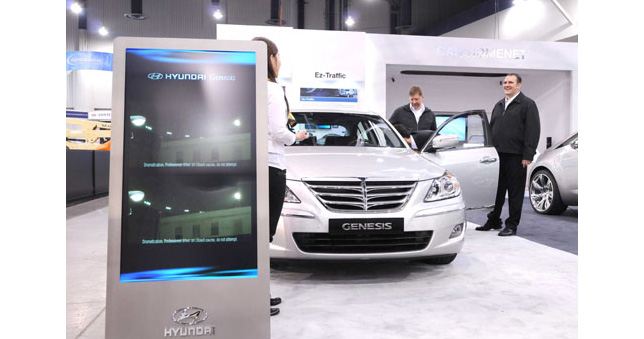Hyundai Makes New Connections At CES Las Vegas Debut, World´s Largest Electronics Show
Hyundai Motor Company will showcase some of its newest infotainment technologies in its debut at the 2009 International Consumer Electronics Show (CES), which opens on Jan. 8 in Las Vegas.
"We´re here to show the world a little–known side of ourselves––our world–class IT development capabilities," said Dr. Yang Woong–Chul, President of the Electronic and Eco–Technology Center. "The technologies we´re displaying at CES are either in the process of being implemented in the Korean domestic market or soon will be. We´re here to gauge American public interest," he said.
"Although this is our first CES, we feel right at home because of the fast–growing electronic content in our cars. People want to drive but they still want to be totally connected and we´ll help them do that," he added.
Exhibit highlights include:
Ez–Traffic Driving safety, convenience and comfort move up a notch with the development of Ez–Traffic which uses forward–looking radar to help maintain a safe distance between your vehicle and the vehicle ahead. Regulating the engine control unit and brake control system, Ez–Traffic automatically sets a safe distance from the car ahead and if necessary, automatically brakes the car, brings it to a complete stop if necessary and then automatically resumes acceleration. If the software senses the possibility of a collision, the emergency braking mode brings the car to a stop within the shortest distance possible.
Digital Mobile TV Enjoy high–definition television entertainment at any speed! Hyundai brings digital TV broadcasts into the car with the world´s first mobile TV system capable of receiving high–definition video and audio at vehicle speeds of up to 180mph. The ATSC–M/H digital broadcast technology is terrestrial–based and operates at 19.4 Mbps. The system can be configured for either free–to–air reception or for subscription–based services, depending on the broadcaster´s business model.

Car–Home Network Utilizes cellular phone network (GSM or CDMA) and wireless networking (Wi–Fi or WiMax) to connect the car with the home. The Car–Home network enables in–car control of home appliances, regulating heating and air conditioning settings, opening and closing of curtains etc. In the event of a home intrusion, emergency alerts and live surveillance video can be sent directly to the driver on the road. The Car–Home Network makes it possible to remotely start–up the car engine from within the home, as well as adjust the climate controls and to seamlessly transfer music and video contents between car and home entertainment systems.
Car Ubiquitous System CUbiS (Car Ubiquitous System) opens the door to a wide variety of new in–car information services using the highly popular Bluetooth wireless communications protocol. For example, at the shopping mall Access Point, retailers could use CUbiS to deliver sales and promotional information via Bluetooth directly into the car or help guide the driver to the nearest available free parking space. At the gas station or service center Access Point, CUbiS can perform vehicle diagnostic checks, issue service alerts, analyze the driving history and offer fuel–saving driving tips based on an analysis of driving history. At tollgates, drivers could receive updated traffic information and traffic alerts. At its most basic level, a CUbiS–enabled cellular phone could be used to remotely control the vehicle (door locking and unlocking, engine starting, climate control adjustment, switching lights on and off). Automotive IT Innovation Center
As part of its efforts to strengthen its IT capabilities, Hyundai in partnership with its sister company Kia Motors Corp. and Microsoft Corp. opened the Automotive IT Innovation Center (AIIC) in November 2008. The Center focuses on the development of the next generation of in–car infotainment systems.
The AIIC will serve as an automotive IT technology incubator by supporting research and development activities of promising IT start–ups in Korea. The technologies developed at AIIC are scheduled for gradual application in Hyundai and Kia vehicles beginning in the second half of 2010. The Center will focus on developing technologies such as auto telecommunication, telematics, navigation systems and Location Based Service (LBS), and improving the Human Machine Interface (HMI).
![Hyundai & Bisimoto Genesis Coupe - 1000HP [video]](http://www.automobilesreview.com/uploads/2013/11/Bisimoto-Engineering-Hyundai-Genesis-Coupe-b.jpg)






